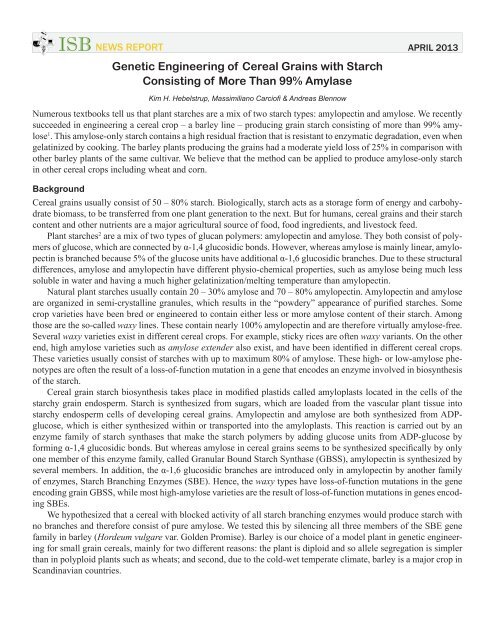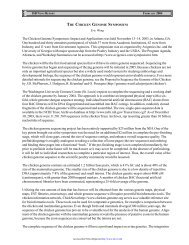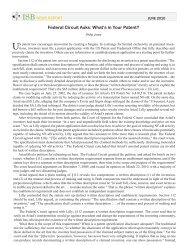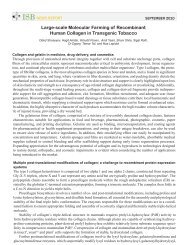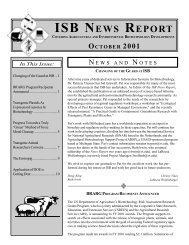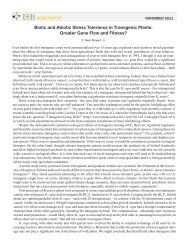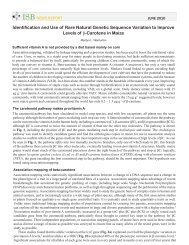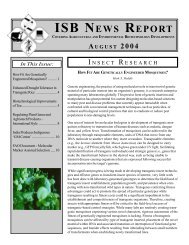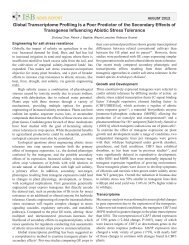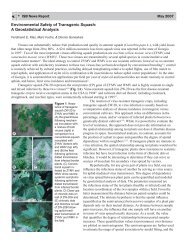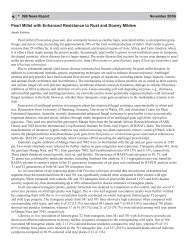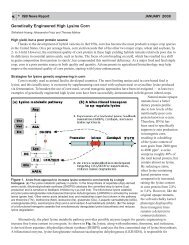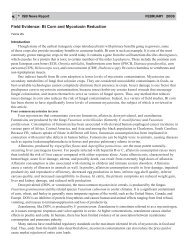Genetic Engineering of Cereal Grains with Starch Consisting of ...
Genetic Engineering of Cereal Grains with Starch Consisting of ...
Genetic Engineering of Cereal Grains with Starch Consisting of ...
Create successful ePaper yourself
Turn your PDF publications into a flip-book with our unique Google optimized e-Paper software.
ISB NEWS REPORT APRIL 2013<br />
<strong>Genetic</strong> <strong>Engineering</strong> <strong>of</strong> <strong>Cereal</strong> <strong>Grains</strong> <strong>with</strong> <strong>Starch</strong><br />
<strong>Consisting</strong> <strong>of</strong> More Than 99% Amylase<br />
Kim H. Hebelstrup, Massimiliano Carci<strong>of</strong>i & Andreas Blennow<br />
Numerous textbooks tell us that plant starches are a mix <strong>of</strong> two starch types: amylopectin and amylose. We recently<br />
succeeded in engineering a cereal crop – a barley line – producing grain starch consisting <strong>of</strong> more than 99% amylose<br />
1 . This amylose-only starch contains a high residual fraction that is resistant to enzymatic degradation, even when<br />
gelatinized by cooking. The barley plants producing the grains had a moderate yield loss <strong>of</strong> 25% in comparison <strong>with</strong><br />
other barley plants <strong>of</strong> the same cultivar. We believe that the method can be applied to produce amylose-only starch<br />
in other cereal crops including wheat and corn.<br />
Background<br />
<strong>Cereal</strong> grains usually consist <strong>of</strong> 50 – 80% starch. Biologically, starch acts as a storage form <strong>of</strong> energy and carbohydrate<br />
biomass, to be transferred from one plant generation to the next. But for humans, cereal grains and their starch<br />
content and other nutrients are a major agricultural source <strong>of</strong> food, food ingredients, and livestock feed.<br />
Plant starches 2 are a mix <strong>of</strong> two types <strong>of</strong> glucan polymers: amylopectin and amylose. They both consist <strong>of</strong> polymers<br />
<strong>of</strong> glucose, which are connected by α-1,4 glucosidic bonds. However, whereas amylose is mainly linear, amylopectin<br />
is branched because 5% <strong>of</strong> the glucose units have additional α-1,6 glucosidic branches. Due to these structural<br />
differences, amylose and amylopectin have different physio-chemical properties, such as amylose being much less<br />
soluble in water and having a much higher gelatinization/melting temperature than amylopectin.<br />
Natural plant starches usually contain 20 – 30% amylose and 70 – 80% amylopectin. Amylopectin and amylose<br />
are organized in semi-crystalline granules, which results in the “powdery” appearance <strong>of</strong> purified starches. Some<br />
crop varieties have been bred or engineered to contain either less or more amylose content <strong>of</strong> their starch. Among<br />
those are the so-called waxy lines. These contain nearly 100% amylopectin and are therefore virtually amylose-free.<br />
Several waxy varieties exist in different cereal crops. For example, sticky rices are <strong>of</strong>ten waxy variants. On the other<br />
end, high amylose varieties such as amylose extender also exist, and have been identified in different cereal crops.<br />
These varieties usually consist <strong>of</strong> starches <strong>with</strong> up to maximum 80% <strong>of</strong> amylose. These high- or low-amylose phenotypes<br />
are <strong>of</strong>ten the result <strong>of</strong> a loss-<strong>of</strong>-function mutation in a gene that encodes an enzyme involved in biosynthesis<br />
<strong>of</strong> the starch.<br />
<strong>Cereal</strong> grain starch biosynthesis takes place in modified plastids called amyloplasts located in the cells <strong>of</strong> the<br />
starchy grain endosperm. <strong>Starch</strong> is synthesized from sugars, which are loaded from the vascular plant tissue into<br />
starchy endosperm cells <strong>of</strong> developing cereal grains. Amylopectin and amylose are both synthesized from ADPglucose,<br />
which is either synthesized <strong>with</strong>in or transported into the amyloplasts. This reaction is carried out by an<br />
enzyme family <strong>of</strong> starch synthases that make the starch polymers by adding glucose units from ADP-glucose by<br />
forming α-1,4 glucosidic bonds. But whereas amylose in cereal grains seems to be synthesized specifically by only<br />
one member <strong>of</strong> this enzyme family, called Granular Bound <strong>Starch</strong> Synthase (GBSS), amylopectin is synthesized by<br />
several members. In addition, the α-1,6 glucosidic branches are introduced only in amylopectin by another family<br />
<strong>of</strong> enzymes, <strong>Starch</strong> Branching Enzymes (SBE). Hence, the waxy types have loss-<strong>of</strong>-function mutations in the gene<br />
encoding grain GBSS, while most high-amylose varieties are the result <strong>of</strong> loss-<strong>of</strong>-function mutations in genes encoding<br />
SBEs.<br />
We hypothesized that a cereal <strong>with</strong> blocked activity <strong>of</strong> all starch branching enzymes would produce starch <strong>with</strong><br />
no branches and therefore consist <strong>of</strong> pure amylose. We tested this by silencing all three members <strong>of</strong> the SBE gene<br />
family in barley (Hordeum vulgare var. Golden Promise). Barley is our choice <strong>of</strong> a model plant in genetic engineering<br />
for small grain cereals, mainly for two different reasons: the plant is diploid and so allele segregation is simpler<br />
than in polyploid plants such as wheats; and second, due to the cold-wet temperate climate, barley is a major crop in<br />
Scandinavian countries.
ISB NEWS REPORT APRIL 2013<br />
Gene silencing technology<br />
We silenced expression <strong>of</strong> all three starch-branching enzyme genes by RNA interference. This was done by engineering<br />
a DNA construct (Figure 1) containing the ubiquitin gene promoter from corn that activates expression <strong>of</strong> a<br />
sense-loop-antisense RNA hairpin. The hairpin consisted <strong>of</strong> three consecutive parts <strong>of</strong> 300 basepairs, each targeting<br />
one <strong>of</strong> the three members <strong>of</strong> the SBE gene family in barley (SBEI, SBEIIa and SBEIIb). Such hairpins are known<br />
to induce degradation <strong>of</strong> mRNA <strong>with</strong> a matching nucleotide sequence. The DNA construct was transferred to the<br />
genome <strong>of</strong> barley plants by Agrobacterium-mediated transformation. We identified 11 independent transgenic lines<br />
showing insertion <strong>of</strong> the DNA construct into the genome, and confirmed a 50 – 90% reduction in the mRNA level <strong>of</strong><br />
all three members <strong>of</strong> the SBE gene family. Similarly we found an 80% reduction in starch branching enzyme activity<br />
in the line <strong>with</strong> the highest reduction in mRNA levels.<br />
Figure 1. DNA construct used to silence the gene family <strong>of</strong> starch branching enzymes (SBEI, SBEIIa and SBEIIb).<br />
The promoter (pink) is the ubiquitin promoter from corn. The construct results in the expression <strong>of</strong> an RNA hairpin construct,<br />
which promotes the breakdown <strong>of</strong> each <strong>of</strong> the three SBE mRNAs. Modified from Carci<strong>of</strong>i et al. 1<br />
Properties <strong>of</strong> amylose-only starch and effects on yield<br />
Amylose and amylopectin content was determined by combined size exclusion chromatography and iodine staining<br />
(Figure 2). Amylopectin molecules are bigger than amylose molecules, and therefore amylopectin is eluted as an<br />
early single peak, whereas amylose is eluted as a broader peak in later fractions <strong>of</strong> size exclusion chromatography. In<br />
addition, amylopectin and amylose can be discriminated by staining <strong>with</strong> iodine. Complexes <strong>of</strong> iodine and amylose<br />
are dark blue <strong>with</strong> an absorption maximum (λ-max) above 600 nm, whereas complexes <strong>of</strong> iodine and amylopectin<br />
are brown <strong>with</strong> an absorption maximum at 540 nm. The size exclusion chromatography shows that normal Golden<br />
Promise barley starch consists <strong>of</strong> a major amylopectin fraction, which is 70% <strong>of</strong> the total starch, and a much broader<br />
fraction <strong>of</strong> amylose, corresponding to 30% <strong>of</strong> the total starch. In contrast, our genetically engineered line consisted <strong>of</strong><br />
two fractions <strong>of</strong> smaller amylose molecules corresponding to > 99% <strong>of</strong> the total starch and a fraction <strong>of</strong> amylopectin<br />
corresponding to less than 1% <strong>of</strong> the total starch.<br />
Figure 2 Combined size exclusion chromatography and iodine staining <strong>of</strong> normal barley<br />
starch and amylose-only starch. Modified from Carci<strong>of</strong>i et al. 1
ISB NEWS REPORT APRIL 2013<br />
This is the first time that an amylose-only plant starch type has been identified. We therefore studied the consequences<br />
<strong>of</strong> eliminating amylopectin in grains. The amylose-only starch was organized in starch granules <strong>with</strong><br />
a different shape than normal barley starch granules (Figure 3). Normal barley starch consists <strong>of</strong> round granules<br />
divided into two sizes—big A-granules and smaller B-granules. The amylose-only starch granules consisted <strong>of</strong> irregularly<br />
shaped granules formed by the gluing <strong>of</strong> smaller round granules. Amylopectin gelatinizes between 60ºC<br />
and 70ºC. No gelatinization <strong>of</strong> the amylose-only starch was observed at that temperature, confirming the absence <strong>of</strong><br />
amylopectin. The absence <strong>of</strong> amylopectin also resulted in complete loss <strong>of</strong> swelling when heated up to 100ºC, and<br />
the solubility was reduced from 60% to 20% when boiled in water.<br />
Figure 3. Scanning electron micrographs <strong>of</strong> normal barley starch and amylose-only starch. Scale bars represent<br />
50 µm and 10 μm in the low and high magnification panels respectively. Arrows indicate A- and B-granules in<br />
normal starch. Modified from Carci<strong>of</strong>i et al. 1<br />
Such a drastic modification <strong>of</strong> endosperm starch could have a negative impact on grain development, yield,<br />
and germination. But we found that the starch content <strong>of</strong> amylose-only grains was only 5% less than normal barley<br />
grains. In a field trial, we found that the germination rate <strong>of</strong> grains from amylose-only plants were the same as in<br />
normal grains. The yield (g grain / plant) was 25% lower in amylose-only plants, mainly due to a lower number <strong>of</strong><br />
spikes and only partly due to smaller grains.<br />
Resistant starch<br />
Digestibility <strong>of</strong> starch is important from a nutritional point <strong>of</strong> view. Rapidly digestible starch results in a quick glycemic<br />
response, due to the formation <strong>of</strong> glucose after hydrolysis by salivary and pancreatic α-amylase. A fraction<br />
<strong>of</strong> dietary starch escapes upper gut degradation and reaches the large intestine where it is fermented by gut bacteria.<br />
This fraction is called resistant starch, and a definition by Englyst et al. 3 divides dietary starch in three fractions:<br />
rapidly digestible starch (RDS), slowly digestible starch (SDS), and resistant starch (RS). Amylose-content has a<br />
direct positive correlation <strong>with</strong> RS content. We found that the amount <strong>of</strong> RDS in gelatinized (cooked) and retrograded<br />
(cooled after cooking) amylose-only starch was 20% and 13%, respectively. In comparison, the amount <strong>of</strong><br />
RDS in the normal barley starch in gelatinized and retrograded starch was 41% and 42%, respectively. Similarly,<br />
the RS fraction was 65% in gelatinized amylose-only starch and 68% in amylose-only retrograded starch, but only<br />
29% both in gelatinized or retrograded normal barley starch.<br />
Conclusions and perspectives<br />
The generation <strong>of</strong> a high yielding amylose-only starch in barley is a pro<strong>of</strong>-<strong>of</strong>-concept that it is possible to genetically<br />
engineer cereal plants to produce starch granules <strong>with</strong>out amylopectin. The mechanism <strong>of</strong> starch biosynthesis<br />
is relatively similar among cereal grains, suggesting that amylose-only starch can also be produced in cereal crop<br />
species other than barley. We used RNAi, but the concept may also be applied using other techniques, such as<br />
mutagenesis breeding. However, it should be emphasized that by using the RNAi technique we present here, the<br />
amylose-only trait segregates as a single locus dominant allele, because the silencing construct was designed to
ISB NEWS REPORT APRIL 2013<br />
target three different genes simultaneously. In contrast, mutagenesis breeding will have to deal <strong>with</strong> segregation <strong>of</strong><br />
all SBE genes in several independent loci. Another aspect <strong>of</strong> the RNAi approach is that the amylose-only trait was<br />
achieved even though not all SBE gene activity was silenced, and therefore we cannot exclude the possibility that<br />
a full loss-<strong>of</strong>-function <strong>of</strong> all SBE gene activity would jeopardize grain filling or otherwise reduce yield much more<br />
than in the barley amylose-only line presented here. A mutagenesis breeding approach may therefore have to include<br />
the combination <strong>of</strong> alleles that do not represent full loss-<strong>of</strong>-function but only partial loss <strong>of</strong> expression levels.<br />
The production <strong>of</strong> amylose-only starch in cereals may provide an opportunity to produce cereal starch for new<br />
functionalities. Amylose, for example, is excellent for generating water-resistant films and bioplastics 2 . Amyloseonly<br />
cereals could therefore provide production <strong>of</strong> starch-based bioplastics directly from extracted starch <strong>with</strong>out<br />
prior amylose extraction. We found that amylose-only starch is very resistant to enzymatic degradation, and that the<br />
amount <strong>of</strong> readily digestible starch in raw as well as gelatinized (cooked) and retrograded amylose-only starch is<br />
much reduced compared <strong>with</strong> normal starch. Such a reduction in amount <strong>of</strong> readily digestible starch is associated<br />
<strong>with</strong> numerous dietary health promoting effects, suggesting that cereal amylose-only crops would be excellent for<br />
dietary purposes.<br />
In conclusion our amylose-only barley acts as a pro<strong>of</strong>-<strong>of</strong>-concept demonstrating that amylose-only starch can be<br />
produced in cereals. We see possible applications suggesting that cereals producing such amylose-only starch may<br />
benefit both the producer by increased crop value due to specialized functionalities, and the consumer by improving<br />
the nutritional value.<br />
References<br />
1. Massimiliano Carci<strong>of</strong>i, Andreas Blennow, Susanne L. Jensen, Shahnoor S. Shaik, Anette Henriksen, Alain Buléon, Preben B. Holm, Kim H. Hebelstrup (2012).<br />
Concerted suppression <strong>of</strong> all starch branching enzyme genes in barley produces amylose-only starch granules. BMC Plant Biology, 12:223<br />
2. <strong>Starch</strong>: Chemistry and Technology, 3rd Edition (2009). Edited by James BeMiller and Roy Whistler. Academic Press, Elsevier Inc.<br />
3. Englyst HN, Kingman SM, Hudson GJ, Cummings JH (1996). Measurement <strong>of</strong> resistant starch in vitro and in vivo. British Journal <strong>of</strong> Nutrition, 75:749–755<br />
Kim H. Hebelstrup, Massimiliano Carci<strong>of</strong>i & Andreas Blennow<br />
Aarhus University, Denmark<br />
University <strong>of</strong> Copenhagen, Denmark<br />
Kim.Hebelstrup@agrsci.dk


